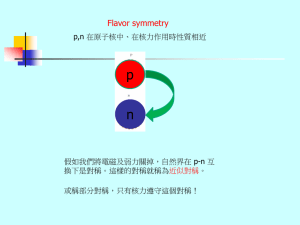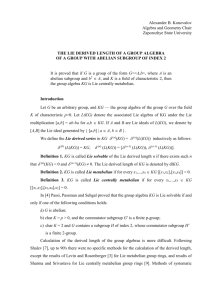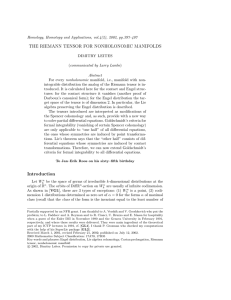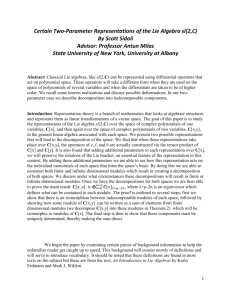Steering
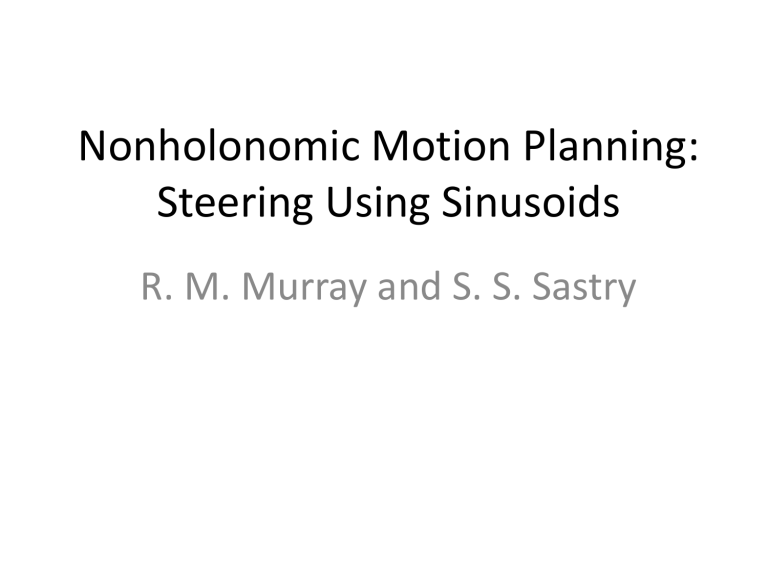
Nonholonomic Motion Planning:
Steering Using Sinusoids
R. M. Murray and S. S. Sastry
Motion Planning without Constraints
• Obstacle positions are known and
dynamic constrains on robot are not considered.
From Planning, geometry, and complexity of robot motion By Jacob T. Schwartz, John E. Hopcroft
Problem with Planning without
Constraints
Paths may not be physically realizable
Mathematical Background
• Nonlinear Control System
:
g
1
( x ) u
1
g m
( x ) u m
• Distribution
span
g
1
( x ), , g m
( x )
Lie Bracket
• The Lie bracket is defined to be
[ f , g ]
g
x f
f
x g
• The Lie bracket has the properties
1.) [ f , g ]
[ g , f ]
2.) [ f , [ g , h ]]
[ g , [ h , f ]]
[ h , [ f , g ]]
0 (Jacobi identity)
Physical Interpretation of the Lie Bracket
Controllability
• A system is controllable if for any x
0
, x
1
U
T
0 and u : [ 0 , T ]
R m s .
t .
satisfies x ( 0 )
x
0 and x ( T )
x
1
• Chow’s Theorem
If
x
R n for all x
U then the system
is controllab le on U
(
is the closure of
under Lie bracketing )
Classification of a Lie Algebra
• Construction of a Filtration
If G
1
span
g
1
( x ), , g m
( x )
G i
G i
1
[ G
1
, G i
1
]
Where [ G
1
, G i
1
]
span
[ g , h ] : g
G
1
, h
G i
1
Classification of a Lie Algebra
• Regular
Classification of a Lie Algebra
• Degree of Nonholonomy
Classification of a Lie Algebra
• Maximally Nonholonomic
• Growth Vector r
Z p
, r i
rankG i
• Relative Growth Vector
Z p
,
i
r i
r i
1
, r
0
0
Nonholonomic Systems
• Example 1
Nonholonomic Systems
• Example 2
Phillip Hall Basis
The Phillip Hall basis is a clever way of imposing the skew-symmetry of Jacobi identity
• Example 1
Phillip Hall Basis
Phillip Hall Basis
• A Lie algebra being nilpotent is mentioned
• A nilpotent Lie algebra means that all Lie brackets higher than a certain order are zero
• A lie algebra being nilpotent provides a convenient way in which to determine when to terminate construction of the Lie algebra
• Nilpotentcy is not a necessary condition
Steering Controllable Systems Using
Sinusoids: First-Order Systems
• Contract structures are first-order systems with growth vector
• Contact structures have a constraint which can be written
• Written in control system form
Steering Controllable Systems Using
Sinusoids: First-Order Systems
More general version
Derive the Optimal Control: First-Order
Systems
• To find the optimal control, define the Lagrangian
• Solve the Euler-Lagrange equations
Derive the Optimal Control: First-Order
Systems
Example
Lagrangian:
Euler-Lagrange equations:
Derive the Optimal Control: First-Order
Systems
• Optimal control has the form where is skew symmetric
• Which suggests that that the inputs are sinusoid at various frequencies
Steering Controllable Systems Using
Sinusoids: First-Order Systems Algorithm yields
Hopping Robot (First Order)
• Kinematic Equations
• Taylor series expansion at l=0
• Change of coordinates
m l
/ 1
m l
Hopping Robot (First Order)
• Applying algorithm 1 a. Steer l and ψ to desired values by
Hopping Robot (First Order)
• Nonholonomic motion for a hopping robot
Steering Controllable Systems Using
Sinusoids: Second-Order Systems
Canonical form:
Front Wheel Drive Car (Second Order)
• Kinematic Equations
• Change of coordinates
Front Wheel Drive Car (Second Order)
• Sample trajectories for the car applying algorithm 2
Maximal Growth System
• Want vectorfields for which the P. Hall basis is linearly independent
Maximal Growth Systems
Chained Systems
Possible Extensions
Canonical form associated with maximal growth 2 input systems look similar to a reconstruction equation
Possible Extensions
• Pull a Hatton…plot vector fields and use the body velocity integral as a height function
• The body velocity integral provides a decent approximation of the system’s macroscopic motion
Plot Vector Fields







